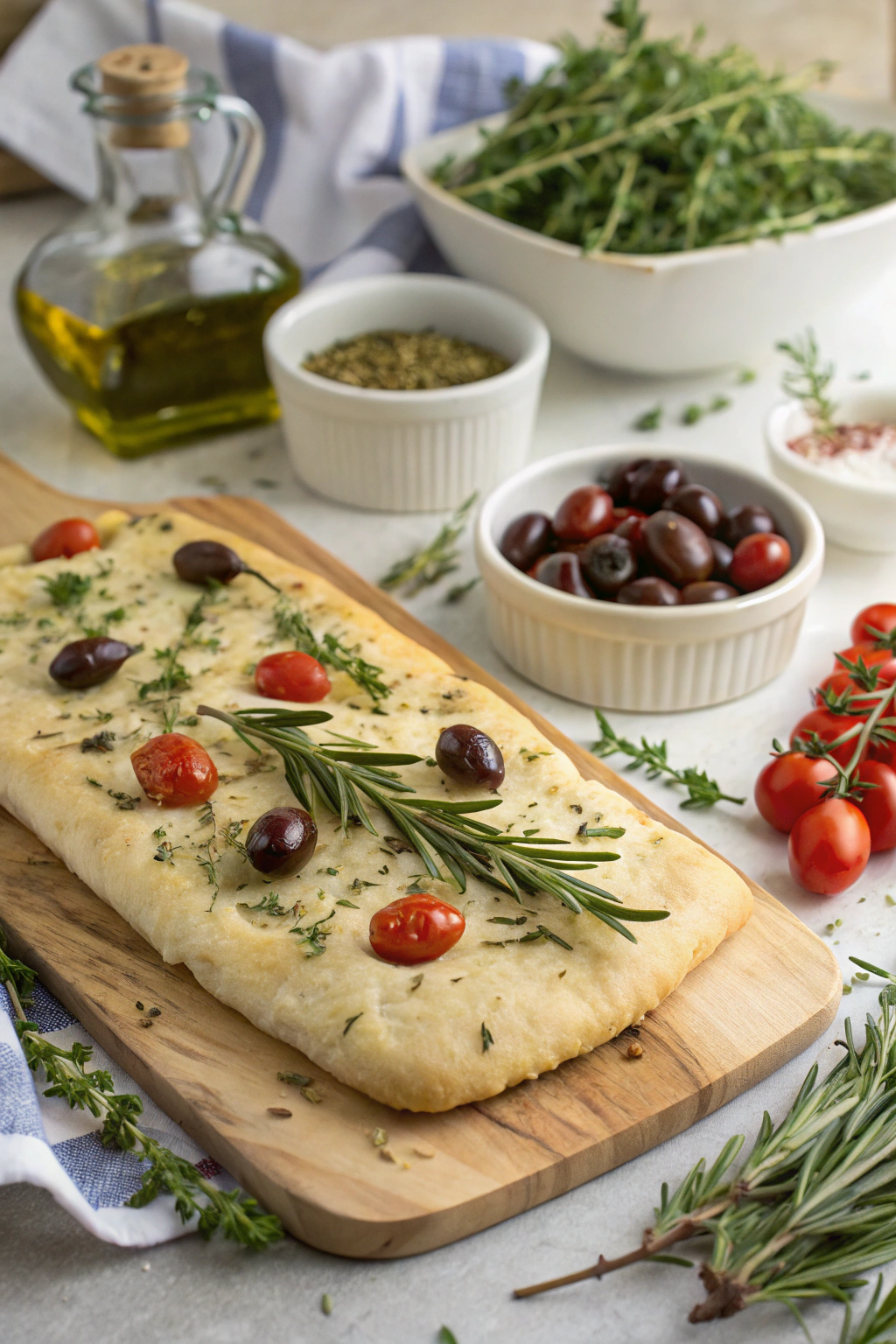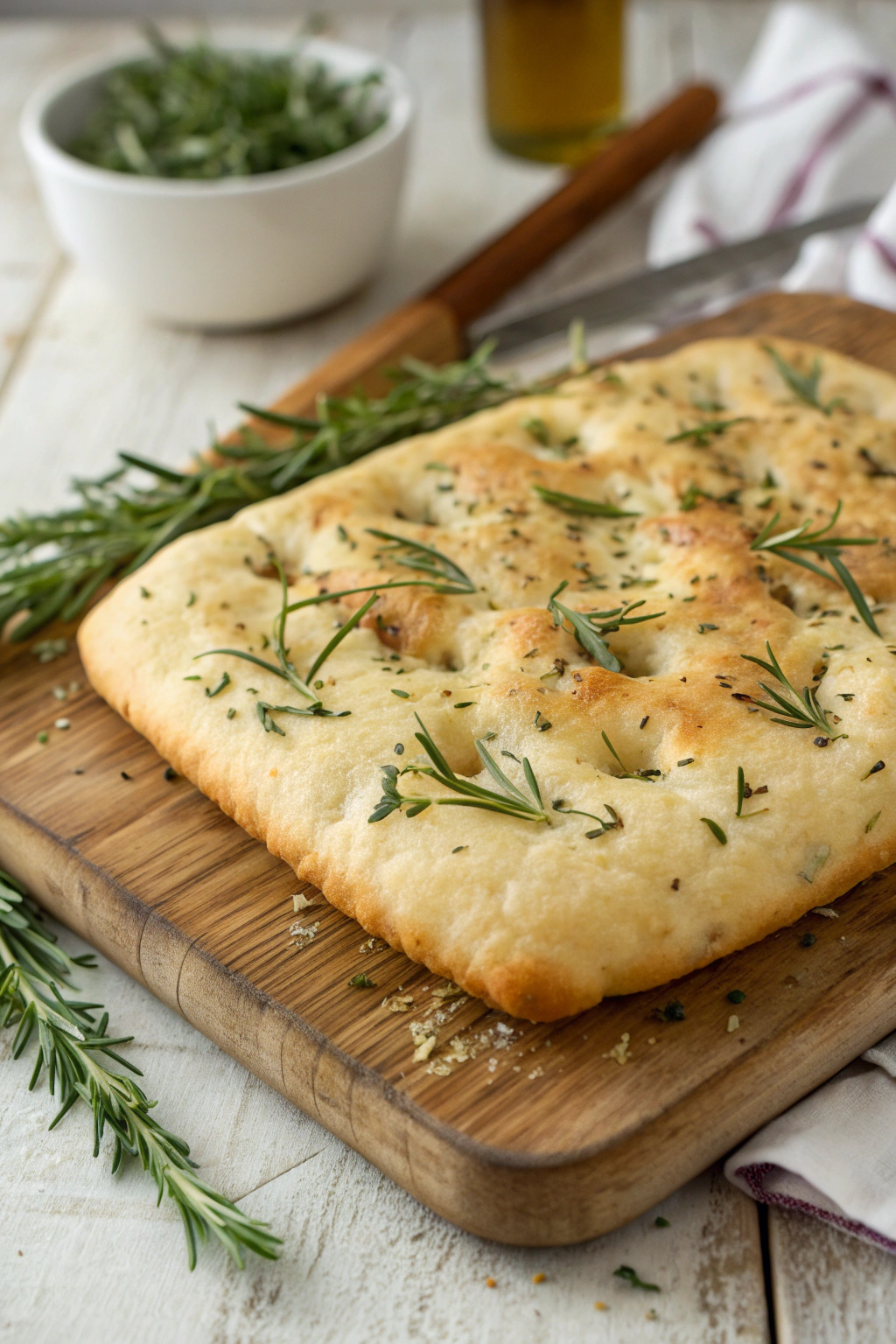Introduction
Do you think making homemade bread is always a time-consuming affair? Think again! This delightful Savory Herb Focaccia proves that a light, airy, and flavorful loaf can be achieved with minimal fuss, perfect for even the busiest home cook.
Q: Can I really make focaccia quickly on a weeknight?
A: Yes. This method trims resting time while keeping good oven spring, so you get a light crumb without an all-day rise.
Ingredients List

- All-purpose flour: 3 cups (360g), providing the foundational structure for that signature airy crumb.
- Active dry yeast: 1 packet (2 ¼ teaspoons), the magical leavening agent that makes our focaccia light and fluffy.
- Warm water: 1 ¼ cups (105-115°F / 40-46°C), crucial for activating the yeast.
- Granulated sugar: 1 teaspoon, a little treat for the yeast to get them going.
- Salt: 1 teaspoon, enhancing all the flavors in the bread. Consider using a flaky sea salt for sprinkling on top for a delightful textural contrast.
- Olive oil: ¼ cup + 2 tablespoons, divided; for a rich flavor and crisp texture. A good quality extra virgin olive oil makes a noticeable difference.
- Fresh rosemary: 2 tablespoons, chopped, adding a fragrant, earthy aroma. Thyme or oregano also work wonderfully.
- Garlic: 2 cloves, minced, lending a pungent, savory depth. Dried garlic powder can be used as a convenient alternative.
Q: Can I use dried herbs instead of fresh?
A: Yes. Use about 1 teaspoon dried for each 1 tablespoon fresh, then adjust to taste.
Q: What kind of olive oil should I use?
A: Extra-virgin boosts flavor, but any olive oil works for baking; drizzle with a good EVOO for finishing.
Prep Time
Prep time: 20 minutes
Cook time: 25 minutes
Total time: 45 minutes
This recipe is approximately 30% faster than traditional focaccia recipes, largely due to a quicker rise time.
Q: What makes this faster than classic focaccia?
A: A single short rise in a warm spot and a high-hydration dough that doesn’t need heavy kneading.
Preparation Steps
Step 1: Activate the Yeast
In a large bowl, combine the warm water, sugar, and active dry yeast. Stir gently and let it sit for 5-10 minutes, or until foamy. This ensures your yeast is active and ready to work its magic. A good tip here is to use a thermometer to check your water temperature; too hot will kill the yeast, too cold won’t activate it.
Q: My mixture didn’t foam. What went wrong?
A: Water outside 105–115°F (40–46°C) or old yeast. Try fresh yeast and recheck the temperature.
Step 2: Mix the Dough
To the yeast mixture, add the flour, 1/4 cup of olive oil, and salt. Mix with a wooden spoon or your hands until a shaggy, somewhat sticky dough forms. Avoid overmixing; a slightly sticky dough is key for a tender focaccia.
Q: How sticky should the dough be?
A: Slightly tacky is ideal; too dry gives a dense crumb, too wet won’t hold dimples.
Step 3: First Rise
Cover the bowl with plastic wrap or a damp towel and let the dough rise in a warm place for 20-30 minutes, or until it has noticeably increased in volume. This is a quick rise, helping to build flavor and texture quickly.
Q: Can I extend the rise for more flavor?
A: Yes. Chill the dough after the first rise (up to overnight), then bring to room temp before shaping.
Step 4: Prepare for Baking
Lightly grease a 9×13 inch baking pan with 1 tablespoon of olive oil. Transfer the risen dough to the pan, pressing it gently to spread it evenly to the edges. Don’t worry if it resists; let it rest for a few minutes if needed, then continue spreading.
Q: Can I use a different sized pan?
A: Yes, a slightly smaller or larger pan will work. Smaller pan = thicker crumb (add 1–3 min). Larger pan = thinner (bake slightly less).
Step 5: Dimple and Top
Using your fingertips, create dimples all over the surface of the dough. Drizzle with the remaining 1 tablespoon of olive oil. Sprinkle with chopped fresh rosemary and minced garlic, then finish with a pinch of flaky sea salt. These dimples will hold the oil and toppings, creating pockets of flavor.
Q: Can I add other toppings?
A: Absolutely! Sliced olives, cherry tomatoes, thinly sliced onions, or grated Parmesan cheese are all fantastic additions.
Step 6: Bake
Bake in a preheated oven at 400°F (200°C) for 20-25 minutes, or until golden brown and cooked through. The exact baking time might vary slightly depending on your oven.
Q: How do I know if my focaccia is cooked through?
A: It should be golden brown on top and sound hollow when tapped on the bottom; internal temp ~95–98°C (203–208°F).
Nutritional Information
Per serving (approx. 1/8 of loaf):
- Calories: 280-320 kcal
- Total Fat: 10-12g
- Saturated Fat: 1-2g
- Cholesterol: 0mg
- Sodium: 350-400mg
- Total Carbohydrates: 40-45g
- Dietary Fiber: 2-3g
- Sugars: 1-2g
- Protein: 7-9g
Q: How can I make a lighter serving?
A: Keep oil in the pan for crust but reduce finishing drizzle; serve smaller squares.
Healthy Alternatives
For a lighter version, consider reducing the amount of olive oil drizzled on top, or use a cooking spray instead for greasing the pan. To make it gluten-free, substitute with a 1:1 gluten-free flour blend, though the texture might be slightly denser. For a dairy-free and vegan version, this recipe is already compliant! Increase the fiber content by adding 1/4 cup of whole wheat flour to the all-purpose flour.
Q: Will the gluten-free version be as airy?
A: Slightly denser—add 1 tbsp oil and avoid overbaking to keep it tender.
Serving Suggestions
Serve this warm Savory Herb Focaccia as a delightful appetizer with a balsamic glaze or a fresh tomato bruschetta. It pairs beautifully alongside hearty soups or crisp salads. For an elegant visual, arrange slices on a rustic wooden board, garnished with a few extra sprigs of fresh rosemary and a small dish of premium olive oil for dipping.
Q: Any fast pairing ideas?
A: Tomato or minestrone soup, crisp salads, antipasti boards with EVOO & balsamic.
Common Mistakes to Avoid
- Water Temperature Too Hot/Cold: As mentioned, water that is too hot will kill the yeast, and too cold will prevent it from activating. Aim for 105-115°F (40-46°C).
- Overworking the Dough: Focaccia thrives on a relatively loose, airy texture. Over-kneading can develop too much gluten, leading to a tough and chewy bread instead of light and tender.
- Insufficient Rise Time: While this is a quicker focaccia, ensuring the initial rise allows the yeast to properly develop flavor and air pockets. Don’t rush this step.
- Skimping on Oil: Olive oil contributes significantly to the flavor, moisture, and crispy crust of focaccia. While you can reduce it for a healthier option, too little will result in a dry bread.
Q: My focaccia came out dense—why?
A: Common causes: water not in range, inactive yeast, overmixing, or dough too dry.
Storage Tips
Store leftover focaccia at room temperature in an airtight container or wrapped tightly in plastic wrap for up to 2-3 days. For longer storage, wrap individual slices or the whole loaf tightly and freeze for up to 1 month. Reheat frozen focaccia in a preheated oven at 350°F (175°C) for 5-10 minutes until warmed through and crisp. To make ahead, you can prepare the dough up to the first rise (Step 3), then refrigerate it overnight. Let it come to room temperature for about 30 minutes before proceeding with Step 4.
Q: Best way to reheat from frozen?
A: 350°F (175°C) for 5–10 minutes straight from the freezer restores crisp edges.
Q: Can I make it ahead?
A: Yes—stop after Step 3, refrigerate overnight, bring to room temp ~30 minutes, then continue with Step 4.
Conclusion
This Savory Herb Focaccia offers a wonderfully simple yet sophisticated way to enjoy homemade bread. Its enticing aroma and irresistible texture make it a versatile addition to any meal, proving that delicious baking can truly be quick and accessible.
Don’t let the idea of baking intimidate you. Give this recipe a try and share the warmth and flavor with your loved ones!
Q: Is this beginner-friendly?
A: Absolutely—no heavy kneading, clear steps, and forgiving dough.
FAQ
Q1: Can I use dried herbs instead of fresh?
A1: Yes, you can. Use 1 teaspoon of dried rosemary for every 1 tablespoon of fresh, adjusting to your taste.
Q2: My focaccia didn’t get airy. What went wrong?
A2: This usually points to inactive yeast or water that was too hot or too cold. Using fresh yeast and checking water temperature is key.
Q3: Can I add other toppings?
A3: Absolutely! Sliced olives, cherry tomatoes, thinly sliced onions, or grated Parmesan cheese are all fantastic additions.
Q4: How do I know if my focaccia is cooked through?
A4: It should be golden brown on top and sound hollow when tapped on the bottom.
Q5: What kind of olive oil should I use?
A5: A good quality extra virgin olive oil enhances the flavor significantly, but any olive oil will work for baking.
Q6: Can I make this in a different sized pan?
A6: Yes, a slightly smaller or larger pan will work, just adjust baking time as needed; a smaller pan might require a couple more minutes, a larger one a few less.
You Might Also Like
- If you love the aroma of freshly baked bread, our Buttery Garlic Knots are a perfect complement, offering another irresistible savory bite.
- For another easy and comforting meal, consider making a batch of Cozy One-Pot Lasagna Soup, perfect for pairing with your focaccia.
- Explore simple baking further with our Easy Pumpkin Quick Bread, a delightful, moist loaf that comes together in no time.
- For an amazing, traditional focaccia bake, try this classic Rosemary Focaccia recipe on Serious Eats for a deep dive into the art of Italian bread.
- If you’re looking for other savory bakes, Bon Appétit has an excellent guide on Savory Bread Recipes that might inspire your next kitchen adventure.

Food lover & recipe creator sharing simple, protein-rich recipes for busy lives.

